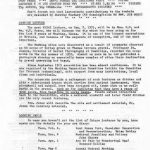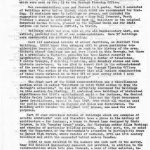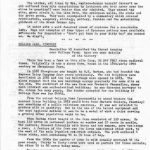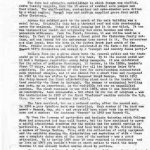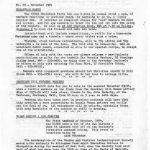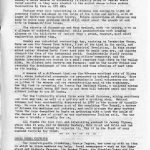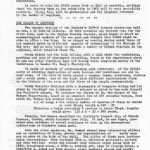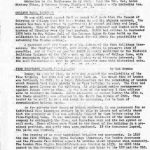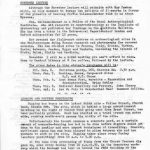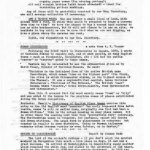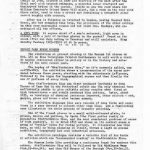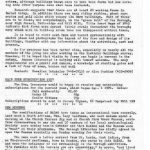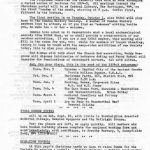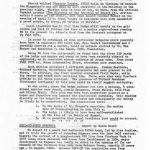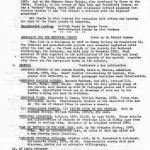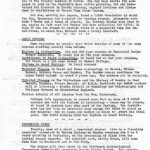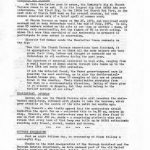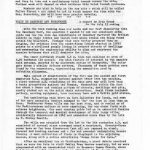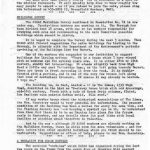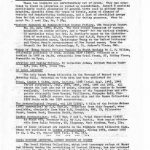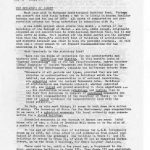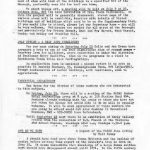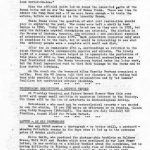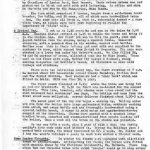Newsletter
Page 1
With this issue the Newsletter achieves its half-century. When it began in October 1969 it was a page-and-a-half long, appeared sporadically at about two-monthly intervals and was circulated to about 100 members. Today it is often difficult to compress it into its four-page straight-jacket and it comes out (we hope we are not tempting Providence) almost like clockwork at monthly intervals.
This seen as a suitable moment to pay tribute to two members who make this possible: Philippa Bernard, who not only gives the Society’s duplicator house-room, but is responsible for running-off the whole of each issue; and Harry Lawrence, who writes and fills the envelopes and expends much ingenuity on ideas for cutting in the postage bill. He and Philippa now cater for a circulation of nearly three times as large as five years ago — some 270 members and a number of complimentary copies — so this is no small job to do twelve times a year.
There is a full file of newsletters 1-50 in the HADAS book box. Anyone who wants to complete his or her file by replacing missing back numbers can get spare copies of many issues, at a cost of 10p each, by asking the Hon. Secretary; but a few numbers are out of print — notably, Nos. 1-5, 8, 10-12, 19, 25, 27, 30, 38 and 48. If you want to replace any of these, we suggest you borrow the book box copy from George Ingram, photo-copy it and return the original to him.
Looking Ahead
1 April — the day this Newsletter will probably reach you — sees the final lecture of this winter season, when Desmond Collins speaks to us about Neanderthal man.
20 April will be half-day trip to Willington, St. Ives and Godmanchester. Bookings are now closed: the coach is full and there is a waiting list.
6 May. Annual General Meeting. The Notice Calling this is enclosed with this Newsletter. The proceedings will start with coffee at 8.00p.m. at Central Library, The Burroughs, NW4; at 8.30 the business of the Meeting will begin. After business is completed, there will be a film, made by the Central Office of Information, “Caring for History”. It shows the work done by the Department of the Environment in restoring and preserving ancient monuments, and includes pictures of Hadrian’s Wall, Fountains Abbey, Conway and Stirling Castles and Audley End.
As a reminder, here are they all-day outings this summer:
Sat May 17 – The excavations at Mucking, Essex.
Sat June 14 – Maiden Castle and Dorchester
Sat. July 12 – Norwich
Sat Sept. 13 – Lullingstone Roman villa and Knole
A cordial invitation to HADAS members comes from the Camden History Society to a lecture by Charles E. Lee on Camden’s Lost Railways on 17 April at 7.30p.m. at the Working Men’s College, Crowndale Road, NW1.
The March lecture — Medieval Jewellery and Pottery
A report by Christine Arnott.
This unusual lecture grew in interest as the evening progressed. Our lecturer — John Cherry, Assistant Keeper in the Department of Medieval and Later Antiquities at the British Museum — led us skilfully forward from simple pottery sherds to jewellery so complex that it would be difficult, if not impossible, to reproduce it today.
Page 2
One special aspect was slides of a selection of medieval prints and illuminated manuscripts portraying the pottery and jewellery in use. We were transported back in time to see the prototypes of the saucepan and frying pan and to watch how meals were cooked, the cottager warmed his feet by the fire, how the great were served at table and what tools were used to slice and divide the meats. Jewellery was shown adorning people in portraits; there were examples of the badges worn by retainers of Richard II and Richard III and even a religious triptych in which the Angels wore the Royal badge.
The pottery ranged from lowly and decorated cooking pots through tall slim 16 in. high jugs, often glazed, to speciality pieces from regional potteries in England and eccentric, over-elaborate jugs from the continent. The range of metalware ran from small tableware in silver, such as spice holders, to very tall bronze jugs that could have held hot water for the royal hands.
The jewellery was fascinating, particularly since the earlier slides had enlarged our knowledge of the period. The piece-de-resistance was the exquisite Swan jewel, found at Dunstable in 1965, which made us all green with envy.
The evening produced many side lights on the social scene: for instance, potters (the earliest traders) were taxed at 4d per annum while of the normal craftsman rate was 6d. We also learnt that elaboration in clothing was permitted only within the limits of a strict social scale — plenty of class stratification there!
Boundary Stones
The research Committee is planning a new field-work project: a survey of all the remaining parish boundary stones in the London Borough of Barnet. All interested HADAS members are cordially invited — indeed, urged — to take part in this.
The boundaries of the various parishes which form the modern Borough were at one time marked by stones. Many of these have vanished completely; others may be partly or even wholly buried; but here and there the stones still remain. They are a link with the way of life and social custom in which the parish was the key factor. From Tudor times onwards (when it took over from the then-decaying manor court) until the middle of the last century, the parish vestry provided the administration of local government.
Until the coming of the railways and the improvement in roads in the nineteenth century many people, from birth to death, never moved beyond their own parish boundaries; the parish itself formed the hub, and its boundaries of the limits, of existence.
The history of the parish and its boundaries, in many instances, goes back much further than Tudor days, to what lawyers call “time immemorial”. Some modern parish boundaries remain almost unchanged from those of pre-Conquest Anglo-Saxon estates, granted originally to a lord by a Saxon king. Estate boundary and parish boundary often marched together in the early days because the Saxon Lord frequently founded a church and appointed its priest; and the parish of that original church (no matter how often the church itself was rebuilt) continued unchanged through Norman to later times.
The HADAS survey will plot the position of each remaining boundary stone on a large-scale map; an accompanying index will give the O.S. grid reference of the stone, a description and a photo and/or drawing.
This will clearly be a long-term project on which many people can work at their own pace. If you would be prepared to help in your area (we hope that no one will have to travel far from home to do their research) please ring or write to our Hon. Secretary and let her know.
One member, Paddy Musgrove of Finchley, has already done some work in his area and has made some unexpected discoveries. For instance, he has found a documentary reference to a boundary stone (though he hasn’t yet located the stone itself) which was set up on an island on the Finchley/Hendon border; another has been found inside the pantry of a house. The living room, to the south of the stone, lay in Hampstead parish; the kitchen, to the north, was in Hendon. Boundary stones obviously occur in some unobvious places.
Page 3
Minimart
to all the good cooks who made things,
to all the good gardeners who grew things,
to all the good drivers who ferried things,
to all the good organisers who fixed things,
to all the good sellers who sold things,
to all the good buyers who bought things,
to all the good members who provided things,
and to all the good people who
manned the door, ran the stalls, collected
the money, gave coffee on demand, cleared
up the cups, tidied the hall, publicised
HADAS and charmed us into the raffle …
THANK YOU SO MUCH. after I he and of 19 hours are men are
How much can we tell you with bated breath: we never dared to hope for the profit we made: over £160. What this means to the Society is indicated below.
1975-6 Subscriptions
A reminder from the Hon. treasurer.
Members’ subscriptions to HADAS are now due, as the Society’s financial year begins on 1 April, 1975. The subscription remains unchanged at:
full member £1
Under-18 £0.65
senior citizen £0.75
A remittance is enclosed with this newsletter. Please complete and send it while you think of it. The former can also be used to order copies of the Society’s 2 Occasional Papers. The first of these – Chroniclers of the Battle of Barnet — has just been reprinted for the second time, so members who missed buying it on previous occasions can remedy the deficiency now.
This year members have the option of paying their current and future subscriptions by Standing Order through their Bank. If you would like to take this up, please complete the enclosed special form and send it to the Hon. Treasurer.
Although, like everyone else, HADAS is facing steeply rising costs, we are managing to hold subscriptions at their present rate for another year. This is due solely to the hard work of the Fund-raising Committee. That is why the Minimart was such a good effort — and why we urge you to support our fund-raisers in all their future efforts.
We have purposely mentioned no names in our thanks to the Minimart helpers: but there is a one name to which we must draw attention in connection with this successful occasion. It is that of Christine Arnott, chairman of the Fund-raising Committee. In that capacity she gave hours of time and thought, as well as carrying the final responsibility for whether the event succeeded or failed. HADAS is very much in her debt.
Guildhall Conference
The 12th Conference of London Archaeologists took place at Guildhall on 22 March. Five papers presented different aspects of London archaeology, including one each on digs at Shadwell and Staines and a round-up or a massive programme of excavation and publication undertaken last year by the City Urban Archaeology Unit.
A report on the seventeenth century stone-ware kiln in Woolwich was significant because, taken in conjunction with recent discoveries at Fulham, it may necessitate some considerable re-thinking of previous theories on the manufacture and dating of “Bellarmine”.
Page 4
There was a paper on Settlement Patterns in Greater London, deduced from known sites and finds and illustrated by a series of distribution maps from the Palaeolithic onwards. The maps showed the curious recurring dearth (as compared with most other urban areas) of known sites and finds in the London Borough of Barnet at almost every period. Barnet’s lack of impact on the archaeological scene (with the honourable exception of Brockley Hill) may be due to the natural cause (as we are often told) that the terrain was too heavily wooded to provide a setting for early settlement. Be that as it may, the white space on each succeeding distribution map, spotted with only an occasional mark of interest, became depressing. Are they really so few sites in Borough, or is it that no one has yet managed to find them?
One site in LBB was on show at the Conference. Ted Sammes and Jeremy Clynes mounted an excellent display of material from the Church Terrace dig, with evidence from the Roman period to the nineteenth century.
A Victorian Miscellany
Report on the current Church Farm House Museum Exhibition by Michael Bird.
Although it may not provide a coherent impression of the Victorian age, the almost magpie eccentricity of this exhibition of Victoriana belonging to Church Farm House Museum has great fascination.
From the intriguing “bijou skirt holder” to a formidable “Archimedean lawnmower” (62s. from Harrods, 1895) the objects possess an intimate domesticity and period quaintness. 9 year old Fanny Page’s dolls’ clothes display the virtuoso needlework of a conscious artist; while her sampler, with its uncompromising injunction to “obey your parents”, hints at a stern moral precocity.
A case full of intimidating household ironware includes a crimping machine and streamlined goffering iron and in the same room is a selection of Wedgwood “Asiatic pheasant” plates which, despite appearances, seem to have come from the Redhill Workhouse. Rustic earthenware flasks, a painted truncheon, wooden corn-measures and the reputed riding-whip of H. Rider Haggard share a case with a handbag and scent bottle. Nearby, providing a sort of touchstone of elegance, is the caligraphy of Frank Allsop’s exercise books and photocopies of more of his work on topical concerns from the “Cares of Greatness” to “Good out of Evil”. Also worth looking at is a collection of amateur watercolours, mostly of Hendon in the 1850s, and a magnificent, if shapeless, trousseau.
For those who feel that lack of schematisation is a disadvantage, this refreshingly indiscriminate miscellany justifies itself with the fact, proclaimed in the catalogue, that “all these articles are not usually on display”. The exhibition continues until 27 April.
Book Review
London Studies, No. 1, 1974. £1.50 from Dillons, 1 Malet Street, WC1.
This publication of 112 A4-size pages contains ten articles, 8 by Dr Francis Celoria. It is an interesting hotch-potch of archaeology, industrial archaeology and folklore. To the latter 49 pages are devoted: the anecdotes were originally collected by J. Pemslie between 1860-93. This section contains several references to our area, and is well indexed. Other material includes Pottery Machinery in Vauxhall, a list of find-spots of Neolithic Axes and an illustrated list of London iron tools which should interest HADAS gardeners and handymen.
Georgian Hadley, by W. H. Gelder, pub. Cowing & Son, 75p.
This reprints in book form articles which appeared first in the Barnet Press. It tells the history of 25 Hadley houses, taking you inside each to meet the present owner and see the interior features. Illustrated by a good photograph of each exterior.

